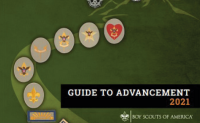 Have you ever listened to a talk, attended a training session or even tried to read an article or paper that contained unexplained abbreviations and terminology that you were unfamiliar with?
Have you ever listened to a talk, attended a training session or even tried to read an article or paper that contained unexplained abbreviations and terminology that you were unfamiliar with?
If so, then you know what it’s like when someone who is new to our field of endeavor tries to listen in on our conversations.
“So then, the DE said to our UC, ‘407 had a great FOS this year, and all their ASMs have their LST. That and the high percentage of TAY they’re serving will help their JTE numbers’.”
Even terms that we take for granted, like merit badge and patrol and abbreviations like SPL and PLC, can be bewildering to people new to our movement. And at this time of year, we are welcoming many new people into Boy Scouting as they and their families cross over from Cub Scouts, which has its own terminology. It takes a lot of getting used to the language of Cub Scouting – some people never quite get the distinction between pack and den, which many confuse with troop. Now comes along a new set of terms, particularly as newcomers find out about youth leadership and the adult positions and functions.
If you’re a fan of the CBS-TV hit comedy The Big Bang Theory, you may recall the episode in which Sheldon, standing up in the wedding of two friends, starts delivering a tribute to the wedding couple in the Klingon language. Stephanie Scotti uses this in her SmartBlog on Leadership article as an illustration of why it’s important that the language we use is understandable by the intended audience. We may know what we’re saying, but can an outsider glean the meaning of the terms we use? In her article, Scotti has other pitfalls to watch out for when giving presentations, and it’s well worth reading. Well-edited publications use terminology that’s suited for the readership they’re expecting. Any unfamiliar terms or abbreviations are defined on first use, and full names and titles are given in the context of the article.
We’re going to have many casual conversations with our new members, so it’s important to sense when you’re using too much jargon. Put yourself in their situation, remembering what it’s like to be brand new to Boy Scouting, and try to relate by using clear language rather than abbreviations (such as senior patrol leader instead of SPL) and making sure they know the meaning of the term (clarifying, if necessary, that the senior patrol leader is the top elected youth leader).
If your troop holds a new member orientation session, be sure that you define the terms unique to Scouting as part of your presentation. Try not to throw around abbreviations and other jargon, but rather use the terms in full. It won’t be necessary to give definitions on each use, but do try to sense when people are confused and open up your explanations. You could even do a dry run of your presentation for a new parent or an existing member who is still fairly new, with an ear toward picking out anything that could be confusing or unfamiliar. Fine-tune your talk so there’s no ambiguity and no undefined abbreviations to cause people to stop and wonder what you’re talking about.
Speaking a common language clearly helps to foster acceptance and solidify relationships, which is especially important for our new members. Soon they’ll pick up on the language of Scouting and you’ll be having what you’d think of as “normal” conversations, but do get them off on the right foot by being clear in your communication with them.
Image by Stuart Miles / freedigitalphotos.net
This post first appeared on Bobwhite Blather.




DE=District Executive
UC=Unit Commissioner
‘407=????
FOS=Friends of Scouting
ASM= Assistant Scoutmaster
LST= Leader Specific Training
TAY=Total Available Youth
JTE=Journey to Excellence
You are an abbrev-master! 407 = any old unit number (happens to be mine).